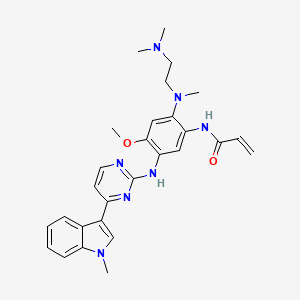m6A-centered Drug Response Information
General Information of the Drug (ID: M6ADRUG0090)
| Name |
Osimertinib
|
||||
|---|---|---|---|---|---|
| Synonyms |
Osimertinib
Click to Show/Hide
|
||||
| Status | Approved | [1] | |||
| Structure |
 |
||||
| Formula |
C28H33N7O2
|
||||
| InChI |
InChI=1S/C28H33N7O2/c1-7-27(36)30-22-16-23(26(37-6)17-25(22)34(4)15-14-33(2)3)32-28-29-13-12-21(31-28)20-18-35(5)24-11-9-8-10-19(20)24/h7-13,16-18H,1,14-15H2,2-6H3,(H,30,36)(H,29,31,32)
|
||||
| InChIKey |
DUYJMQONPNNFPI-UHFFFAOYSA-N
|
||||
| PubChem CID | |||||
| TTD Drug ID | |||||
| DrugBank ID | |||||
Full List of m6A Targets Related to This Drug
microRNA let-7b (MIRLET7B)
| In total 1 item(s) under this target gene | ||||
| Experiment 1 Reporting the m6A-centered Drug Response by This Target Gene | [2] | |||
| Response Summary | the participation of Metformin decreased the bindings of DNMT3a/b to the METTL3 promoter with the help of the readers of NKAP and HNRNPA2B1.the mediation of m6A formation on pri-Let-7b processing increased the mature microRNA let-7b (MIRLET7B), whose key role is to suppress the Notch signaling and to re-captivate the Osimertinib treatment.The findings open up future drug development, targeting this pathway for lung cancer patients. | |||
| Responsed Disease | Lung cancer | ICD-11: 2C25 | ||
| Target Regulator | Methyltransferase-like 3 (METTL3) | WRITER | ||
| Pathway Response | Notch signaling pathway | hsa04330 | ||
| In-vitro Model | NCI-H1975 | Lung adenocarcinoma | Homo sapiens | CVCL_1511 |
| HCC827 | Lung adenocarcinoma | Homo sapiens | CVCL_2063 | |
| H1975OR (Osimertinib resistant H1975 cells) | ||||
| HCC827OR (Osimertinib resistant HCC827 cells) | ||||
References